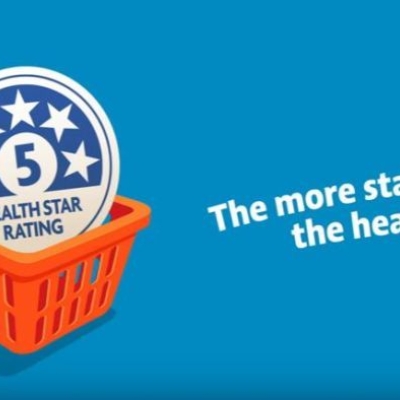Sunday, 14 April 2019 / Topics:

The national Health Star Rating system has been in place for almost five years, but do you know how it works?
The Health Star Rating was developed to help individuals 'make healthier choices at a glance'. The Health Star rating is presented on the front of a packet to allow consumers to quickly and easily compare products within the same food category, for example two muesli bars. It does not compare a muesli bar to a block of cheese.
So, what nutrients does it consider?
Total energy:
Energy is measured by kilojoules (calories) in a product. The average adult should consume 8500kJ per day, which equates to 2000 calories. Energy is considered in the rating because excess energy intake may cause weight gain, which increases the risk of chronic diseases.
Saturated fat:
Saturated fat is one type of fat found in many foods, primarily animal-based foods and processed foods. It is recommended that saturated fat should make up no more than 10% of a person’s total fat intake as it leads to an increase in blood cholesterol which is associated with an increased risk of heart disease.
Sodium:
Sodium is found in salt and the National Heart Foundation recommends that adults should not consume more than 5g of salt per day, this is equivalent to 200mg of sodium, due to associated increased risks of cardiovascular disease.
Sugar:
Sugar can be derived from added sugar such as table sugar or maple syrup, or it can be derived from natural sources such as fruit. This is where you have to be careful when using the health star rating as it does not differentiate between added and natural sugars. Sugar is considered in the rating as excess sugar intake leads to an increased risk of tooth decay, as well as chronic health conditions such as overweight and obesity.
Fibre:
Good sources of fibre include whole grains, fruits and vegetables. On average, an adult should consume 30g of fibre per day. Fibre is a very important nutrient as it decreases the risk of chronic health conditions, including bowel cancer, diverticular disease and heart disease and it helps manage blood sugar levels and cholesterol levels.
Protein:
Protein should contribute approximately 30% of a person’s total daily energy intake. Protein is important for muscle functions as well as metabolic functions such as the production of hormones.
Now that you know the nutrients considered where determining a Health Star Rating, how is a Health Star Rating calculated?
Food products are rated on a scale of ½ a star to five stars, where the more nutritious a product is the higher the rating. The Health Star Rating is calculated using an algorithm developed with nutrition experts and Food Standards Australia and New Zealand (FSANZ). The algorithm takes into consideration the different nutrients which are identified as either positive or risk nutrients depending on how they impact a person’s health. Positive nutrients include fibre and protein, while risk nutrients include energy, sodium, sugar and saturated fat. To allow for a direct comparison of food products, nutrients are considered per 100g or 100ml, rather than per serving size.
The Health Star Rating infographic consists of three elements;
The Star Rating,
The energy declaration, and
The nutrient content declaration.
You may also notice that nutrients like sodium, fibre and saturated fat may be described as ‘high’ or ‘low.’ This provides further information about how much a specific nutrient contributes to your overall daily nutrient requirements. The terms ‘high’ or ‘low’ are determined according to FSANZ's Nutrition, Health and Related Claims schedule. It is important to remember that when calculating the health star rating, the content of each nutrient has been considered. For example, a product with ‘high’ sodium and ‘low’ fibre will receive a lower rating. So, you don’t need to be too concerned by these added descriptors.
A final point to consider
The Health Star Rating is voluntary, meaning that food manufactures can decide whether to include their product’s Health Star Rating. As such, a food product without a Health Star Rating is not necessarily more or less nutritious than its counterpart which has a Health Star Rating. To compare products that do not have a Health Star Rating, it is best to read the Nutrition Information Panel, which can be found on all food product packages. For more information about reading foods labels, keep your eye out for an upcoming post.

